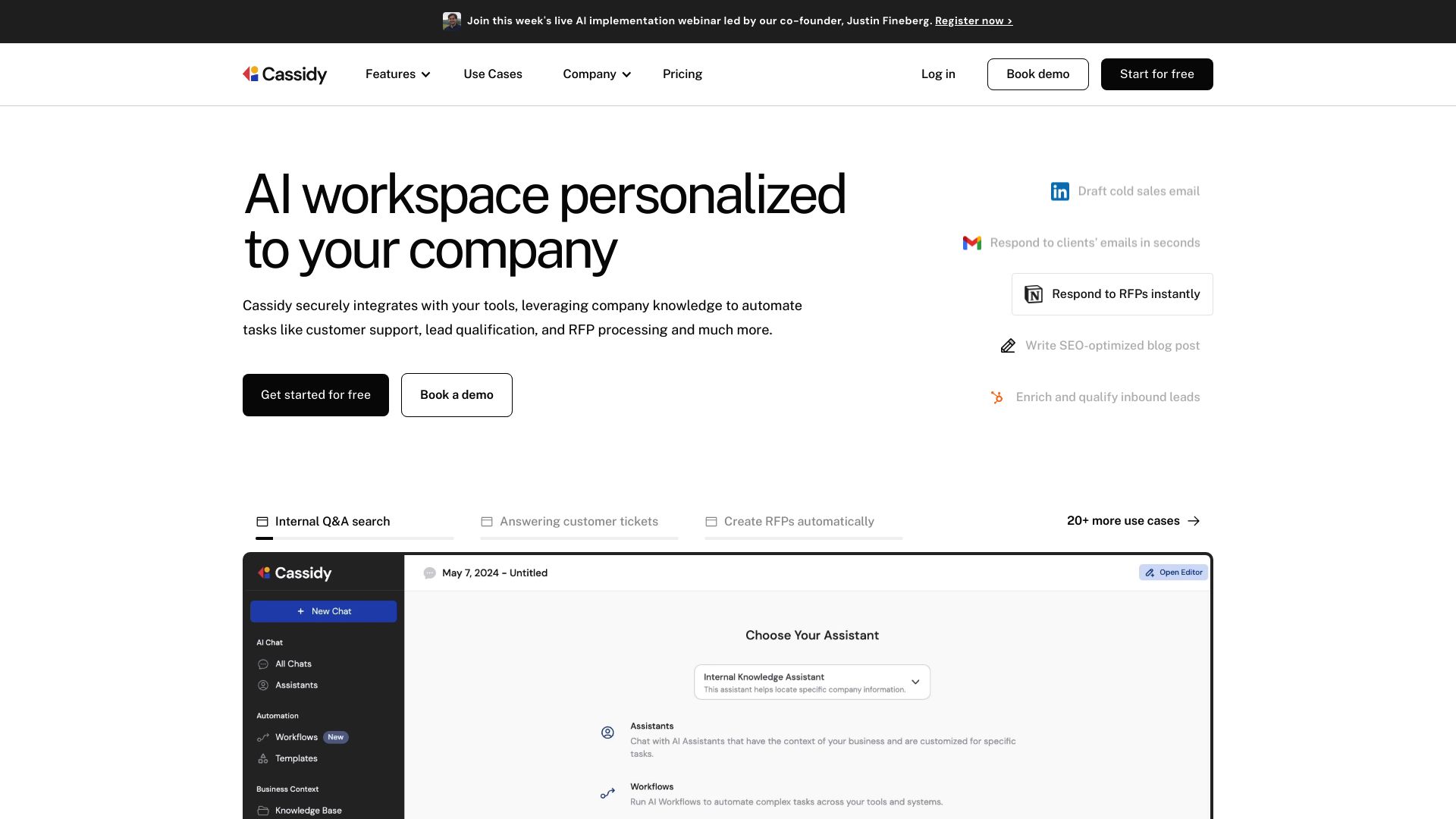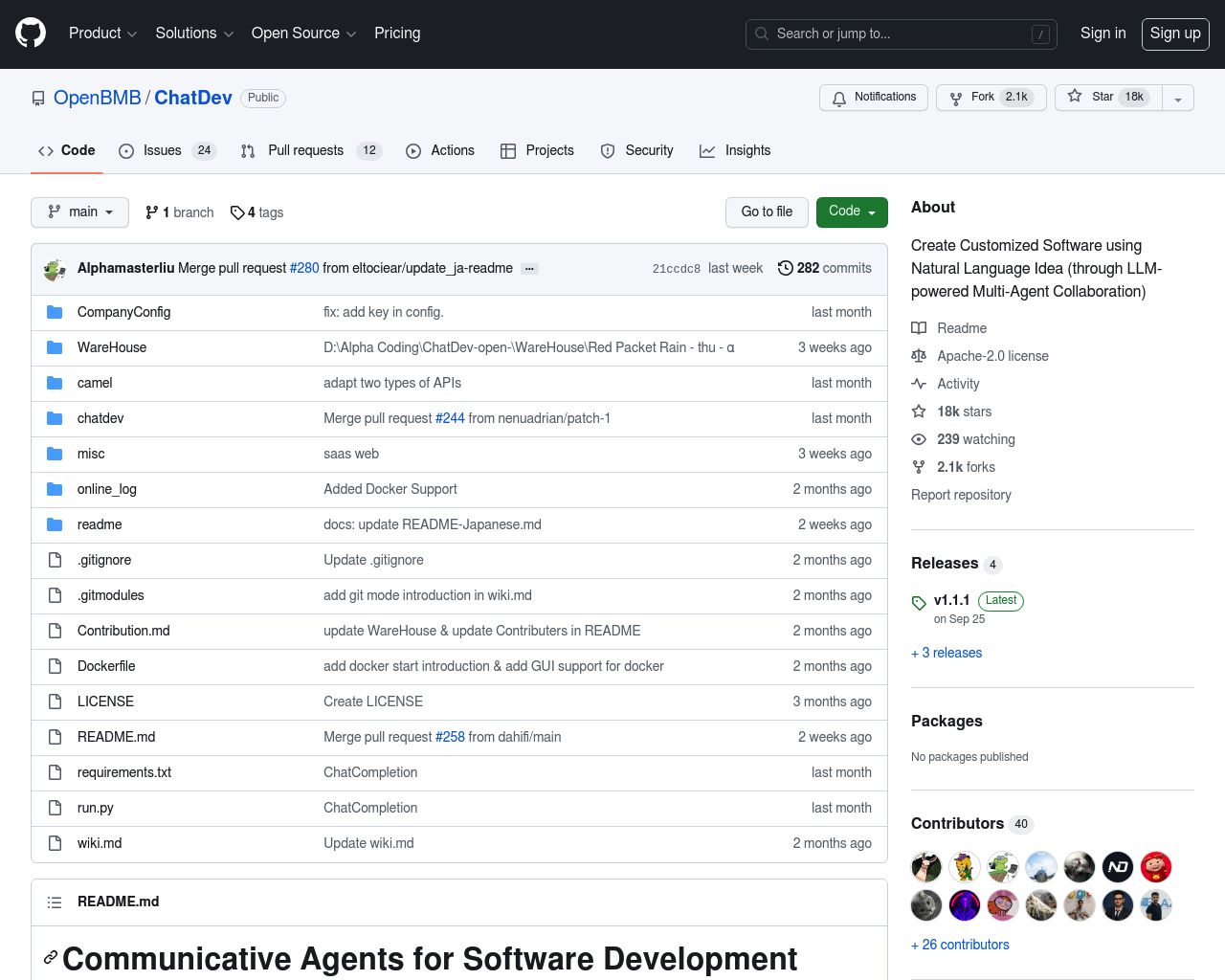Cassidy vs. ChatDev: AI-Driven Development Platforms Compared
The AI landscape continues to evolve, presenting businesses with powerful tools to enhance productivity and streamline operations. This comparison examines Cassidy vs. ChatDev, and SmythOS, three platforms at the forefront of AI-driven software development and automation. Cassidy offers customized AI assistants and workflows, integrating seamlessly with existing business tools.
ChatDev simulates an entire software company, automating the full development lifecycle. SmythOS emerges as a comprehensive solution, combining strengths from both approaches while addressing their limitations. We’ll explore how each platform empowers developers, IT managers, and non-technical users to harness AI capabilities, evaluating their features, security measures, and overall impact on software creation and business processes. This analysis aims to guide readers in selecting the most suitable AI solution for their specific needs and technical expertise.
Cassidy Overview
Cassidy offers a powerful platform for building customized AI assistants and workflows tailored to specific business needs. The software enables companies to create intelligent agents that leverage existing knowledge bases and integrate seamlessly with current tools and systems.


Cassidy’s no-code visual builder allows users to design complex AI-powered workflows without programming expertise. The platform supports integration with various data sources like Google Drive, Slack, and Notion, enabling AI assistants to access and utilize company-specific information. This contextual awareness enhances the ability of Cassidy’s agents to handle tasks ranging from customer support to lead qualification and RFP processing.
Cassidy’s no-code visual builder allows users to design complex AI-powered workflows without programming expertise.
A key strength of Cassidy lies in its model-agnostic approach. The platform allows businesses to leverage any foundational AI model, providing flexibility and future-proofing AI strategies. This adaptability, combined with enterprise-grade security measures that ensure data confidentiality, positions Cassidy as a robust solution for organizations looking to implement AI at scale.
While Cassidy excels in many areas, potential limitations include the absence of specific features like a debug mode for troubleshooting workflows and support for multimodal inputs. Additionally, the platform does not appear to offer a hosted vector database or specialized crawlers for data ingestion from sources like sitemaps or YouTube transcripts. These factors may impact its suitability for certain use cases or industries with specific data handling requirements.
Overall, Cassidy represents a comprehensive AI agent builder focused on empowering businesses to harness AI capabilities through intuitive tools and seamless integrations. Its emphasis on customization, security, and scalability makes it a strong contender for organizations seeking to enhance productivity and operational efficiency through AI-driven automation.
ChatDev Overview
ChatDev revolutionizes software development by automating the entire process using large language models. This open-source framework simulates a virtual software company, where intelligent agents collaborate to design, code, test, and document software projects.


ChatDev’s multi-agent system assigns roles like CEO, CTO, programmer, and tester to different AI agents. These agents communicate through a structured chat chain, breaking down complex development tasks into manageable steps. The framework leverages innovative mechanisms such as thought instructions and self-reflection to minimize errors and improve code quality.
ChatDev delivers impressive results, capable of developing a simple software application in under seven minutes for less than one dollar.
One standout feature of ChatDev is its ability to replay the entire conversation between agents in a web app, providing unparalleled transparency into the development process. The framework also integrates with Git for version control, enabling collaborative and concurrent development practices.
ChatDev delivers impressive results, capable of developing a simple software application in under seven minutes for less than one dollar. It generates all necessary components, including source code, user manuals, and environmental dependencies. While ChatDev offers significant advantages in speed and cost-efficiency, it may face challenges in handling highly complex projects or integrating with legacy systems that require extensive human expertise.
By automating the software development lifecycle, ChatDev aims to make the process more accessible, efficient, and cost-effective. However, users should consider the potential limitations in customization and the need for human oversight in critical decision-making processes when evaluating its suitability for their specific project requirements.
Feature Comparison
Cassidy and ChatDev offer distinct approaches to AI-powered software development, each with unique strengths and limitations. Cassidy provides a comprehensive platform for building customized AI assistants and workflows, focusing on enterprise integration and no-code development. ChatDev, in contrast, simulates an entire software company using AI agents to automate the full development lifecycle.
Cassidy excels in its integration capabilities, offering seamless connections with various data sources and business tools. Its no-code visual builder empowers non-technical users to create complex AI workflows. However, ChatDev pushes the boundaries of AI-driven development further by automating the entire process from design to documentation. ChatDev’s multi-agent system, which assigns roles like CEO and programmer to different AI agents, provides a unique approach to software creation that Cassidy does not offer.
While both platforms aim to streamline development, they diverge significantly in their core security features. Cassidy emphasizes enterprise-grade security and data encryption, crucial for businesses handling sensitive information. ChatDev, being primarily focused on the development process itself, does not explicitly highlight such security measures. This gap in security features could be a critical factor for organizations prioritizing data protection in their AI initiatives.
Feature Comparison Table
| Cassidy | ChatDev | SmythOS | |
|---|---|---|---|
| CORE FEATURES | |||
| Visual Builder | ✅ | ❌ | ✅ |
| No-Code Options | ✅ | ❌ | ✅ |
| Autonomous Agents | ❌ | ✅ | ✅ |
| Explainability & Transparency | ❌ | ✅ | ✅ |
| Multimodal | ❌ | ✅ | ✅ |
| Multi-Agent Collaboration | ❌ | ✅ | ✅ |
| Audit Logs for Analytics | ❌ | ✅ | ✅ |
| Bulk Work | ✅ | ❌ | ✅ |
| Agent Work Scheduler | ✅ | ❌ | ✅ |
| SECURITY | |||
| Constrained Alignment | ✅ | ❌ | ✅ |
| IP Control | ❌ | ❌ | ✅ |
| COMPONENTS | |||
| Huggingface AIs | ❌ | ✅ | ✅ |
| Classifiers | ❌ | ✅ | ✅ |
| Data Lakes | ❌ | ❌ | ✅ |
| DEPLOYMENT OPTIONS (EMBODIMENTS) | |||
| Staging Domains | ❌ | ❌ | ✅ |
| Production Domains | ❌ | ❌ | ✅ |
| API Authentication (OAuth + Key) | ❌ | ✅ | ✅ |
| Deploy as Site Chat | ❌ | ✅ | ✅ |
| Deploy as Scheduled Agent | ✅ | ❌ | ✅ |
| Deploy as GPT | ❌ | ✅ | ✅ |
| Scalability | ✅ | ❌ | ✅ |
| DATA LAKE SUPPORT | |||
| Hosted Vector Database | ❌ | ❌ | ✅ |
| Sitemap Crawler | ❌ | ❌ | ✅ |
| YouTube Transcript Crawler | ❌ | ❌ | ✅ |
| URL Crawler | ❌ | ✅ | ✅ |
| TXT File Support | ✅ | ❌ | ✅ |
Best Alternative to Cassidy and ChatDev
SmythOS emerges as the superior alternative to Cassidy and ChatDev, offering a comprehensive platform for AI agent creation and deployment. Our drag-and-drop interface simplifies the process of building complex AI workflows, making advanced AI functionalities accessible to users of all skill levels.
Unlike Cassidy’s limited focus on customized AI assistants or ChatDev’s simulated software company approach, SmythOS provides a versatile ecosystem for developing and managing a wide range of AI agents. We support autonomous agents capable of performing complex tasks independently, a feature lacking in Cassidy and surpassing ChatDev’s capabilities.
SmythOS excels in its extensive integration options, connecting seamlessly with various data sources, APIs, and AI models from providers like OpenAI, Anthropic, and Hugging Face.
SmythOS excels in its extensive integration options, connecting seamlessly with various data sources, APIs, and AI models from providers like OpenAI, Anthropic, and Hugging Face. This flexibility ensures our platform can adapt to virtually any workflow or business process, outperforming both Cassidy and ChatDev in versatility.
Our platform’s robust security features, including data encryption and OAuth support, address the critical need for data protection in AI initiatives—an area where ChatDev falls short. Additionally, SmythOS offers scalable deployment options, from APIs and webhooks to scheduled agents and GPT integrations, providing unparalleled flexibility in how AI solutions are implemented and used across different environments.
With SmythOS, users gain access to advanced features like multimodal support, a hosted vector database, and comprehensive data lake capabilities, enabling the creation of sophisticated AI solutions that can handle diverse data types and complex workflows. These features, combined with our user-friendly interface and extensive customization options, make SmythOS the ideal choice for businesses and developers looking to harness the full potential of AI technology efficiently and effectively.
Conclusion
Cassidy and ChatDev offer powerful AI-driven solutions for software development and automation, each with unique strengths. Cassidy excels in creating customized AI assistants and workflows, integrating seamlessly with existing business tools. Its no-code visual builder empowers non-technical users to harness AI capabilities. ChatDev pushes the boundaries of AI-driven development by simulating an entire software company, automating the full development lifecycle from design to documentation.
While both platforms streamline development processes, they cater to different needs. Cassidy focuses on enterprise integration and workflow automation, making it suitable for businesses looking to enhance productivity across various departments. ChatDev, on the other hand, revolutionizes the software development process itself, potentially reducing time and costs significantly for certain types of projects.
However, SmythOS emerges as the superior choice, offering a comprehensive solution that combines the strengths of both platforms and addresses their limitations. We provide a versatile AI operating system that enables rapid creation, deployment, and management of AI agents across multiple platforms. Our drag-and-drop interface, extensive integration ecosystem, and support for various AI models make advanced AI functionalities accessible to users of all technical backgrounds.
SmythOS stands out with its ability to create multi-agent systems, deploy agents anywhere, and offer enterprise-grade security features. Unlike Cassidy and ChatDev, we provide a hosted vector database, support for multimodal inputs, and specialized crawlers for efficient data ingestion. Our platform’s scalability, transparency, and problem-solving capabilities make it the ideal choice for businesses seeking to leverage AI for innovation and efficiency.
To experience the future of AI-powered productivity and automation, create a free SmythOS account today. Discover how our platform can transform your workflow, enhance your development processes, and drive significant advancements in your industry. With SmythOS, you’re not just adopting an AI tool; you’re unlocking a new era of possibilities for your business.
Last updated:
Disclaimer: The information presented in this article is for general informational purposes only and is provided as is. While we strive to keep the content up-to-date and accurate, we make no representations or warranties of any kind, express or implied, about the completeness, accuracy, reliability, suitability, or availability of the information contained in this article.
Any reliance you place on such information is strictly at your own risk. We reserve the right to make additions, deletions, or modifications to the contents of this article at any time without prior notice.
In no event will we be liable for any loss or damage including without limitation, indirect or consequential loss or damage, or any loss or damage whatsoever arising from loss of data, profits, or any other loss not specified herein arising out of, or in connection with, the use of this article.
Despite our best efforts, this article may contain oversights, errors, or omissions. If you notice any inaccuracies or have concerns about the content, please report them through our content feedback form. Your input helps us maintain the quality and reliability of our information.
